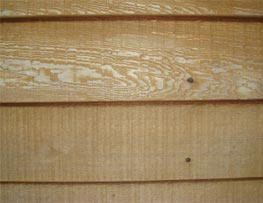Resene Popular Paint Systems –
Exterior and interior woodcare© (stains and clear finishes): training notes
This web page is an edited version of the Resene Best System Selling training notes provided to Resene staff and is provided to enable you to gain a greater understanding of the substrates and paint systems you may encounter in your decorating project. It is impossible to cover all decorating scenarios in a single document, so if you are in doubt about any aspect of your project please contact Resene for assistance.
Select the substrate or area you will be staining or oiling from the list below to view how to prepare and finish the surface.
Preparation & finishing flowcharts
Note: Refer to the PDF flowchart for a visual of the steps below:
Wash with Resene Timber and Deck Wash to remove any dirt and contaminants. Rinse thoroughly and allow to dry.
Sand if practical to remove any sharp edges and any greyed (U.V. damaged) areas.
Finish options:

Washing using Resene Timber and Deck Wash will condition the timber allowing the stain to penetrate more easily and deeply into the timber as well as removing any fingerprints, dirt and rain spotting.

Plywood weathering
Any surface imperfections should be sanded and sharp edges arrised or rounded. This will ensure better coverage. Remember to sand with the grain. (Recommend 120-150 grit garnet paper).
Coat both sides of the timber or board and any cut ends before fixing. This is known as envelope sealing and improves the dimensional stability of the timber, reducing the likelihood of the timber cupping, warping and splitting.
Some timbers, have hard exposed ‘latewood’ grain and stains have trouble penetrating the exposed surface. Another coat may be useful after say three to six months. Depending on the colour, stains may need maintenance after two summers but thereafter have improved life because of material build-up. A similar phenomenon occurs with flat sawn and quarter sawn boards. Stains don’t penetrate as deeply into parts of flat sawn weatherboards and tend to weather more rapidly (and require restaining sooner). The upper board in the photo below is flat sawn and has weathered much more than the quarter sawn board beneath it.
As Plywood and some timbers will crack soon after staining or painting, a good practice is to apply a third coat after 6 months or so. While this isn’t always practical it will help cover splits and checks that typically develop after staining or painting and will ultimately prolong the life of the coating. Shadowclad, a cladding similar to Plywood has a requirement that paints and stains must have a LRV value greater than 40% unless a Resene Cool Colour alternative has been accepted as an alternative solution (by councils and territorial authority).
Rough sawn fences can be rolled using a PAL No.1 or No.2 roller or a Nook and Cranny roller, although a brush will be needed for the edges. Professional painters will often spray Resene Woodsman rather than brush and/or roll.